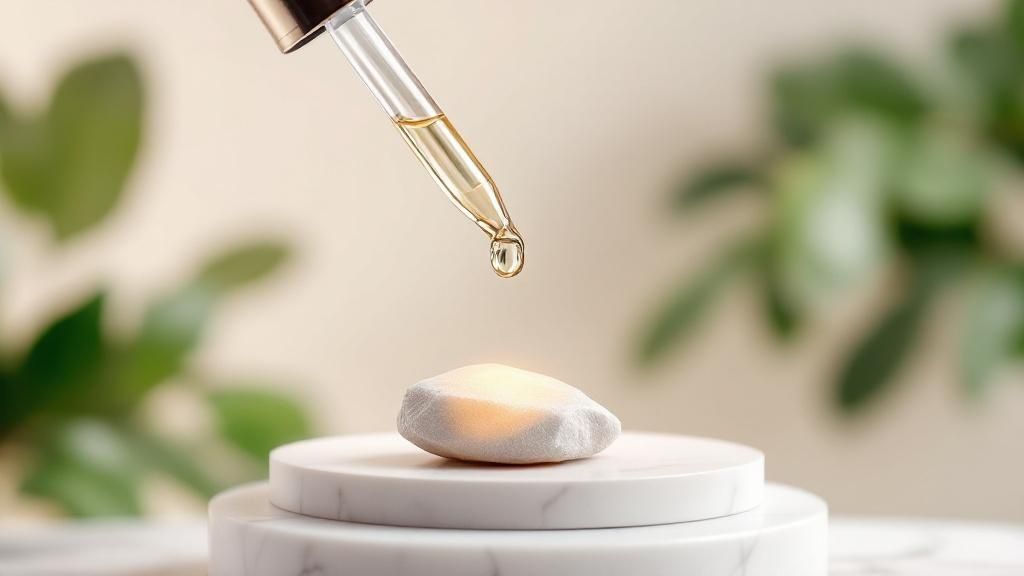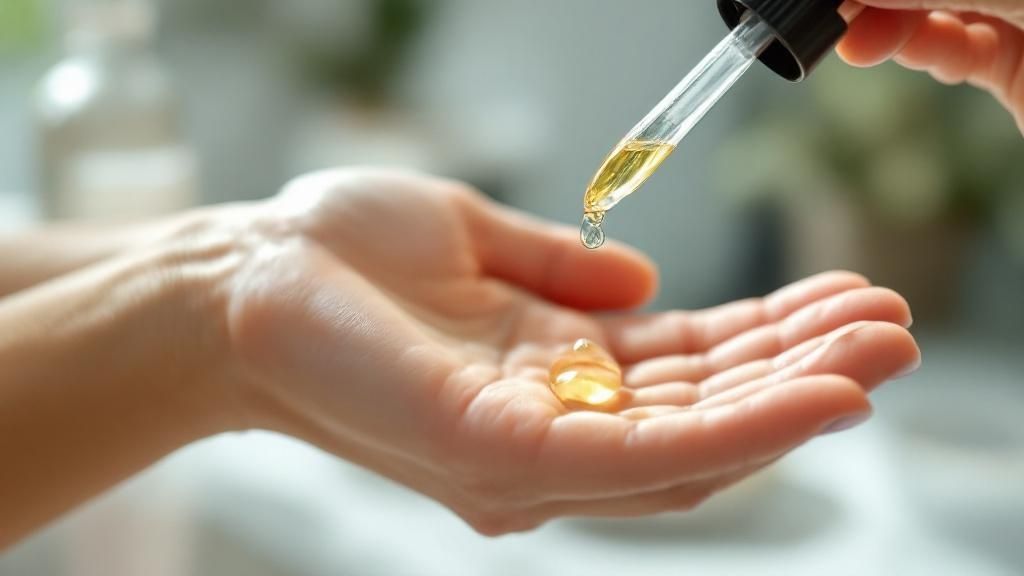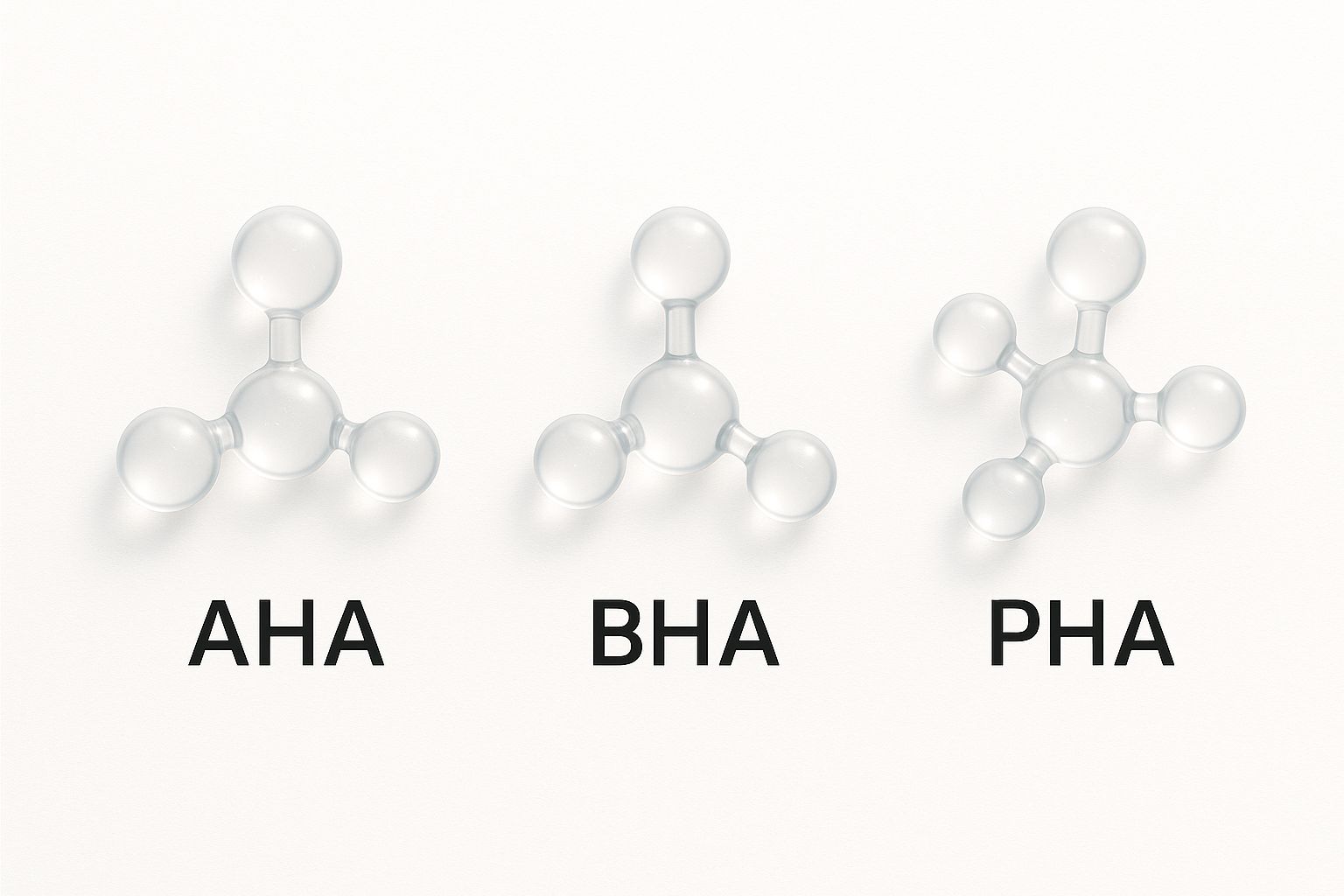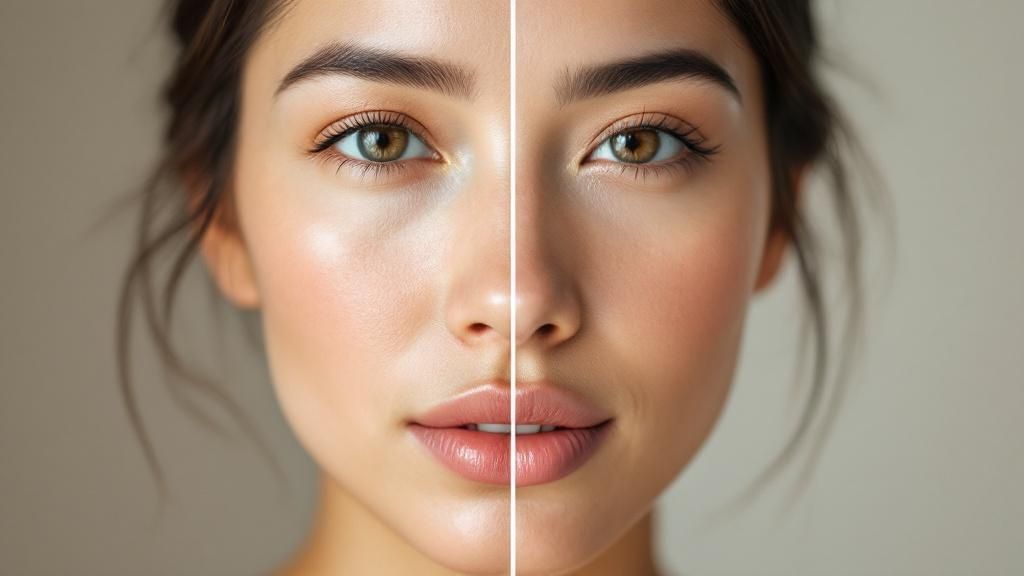
Forget physically scrubbing away dead skin. Chemical exfoliation is a far more elegant approach, using gentle acids to dissolve the invisible "glue" holding dull, old cells to the surface.
Think of it like polishing a gemstone—you’re not scratching it, but gently revealing the brilliant, fresh layer underneath. This process kickstarts your skin’s natural cell turnover, leading to a brighter complexion and a texture that’s noticeably smoother to the touch.
Uncovering Your Best Skin with Science

This is a science-backed method dermatologists and estheticians have relied on for years to get incredible results without the harsh friction of a scrub. And the secret is out—the global exfoliating agent market, valued at a staggering USD 2.5 billion in 2023, is expected to nearly double by 2032. This isn’t just a trend; it’s a major shift toward smarter, more effective skincare.
Unlike physical scrubs, which can sometimes cause micro-tears and irritation, chemical exfoliants work evenly across the skin. They offer a controlled, uniform removal of dead cells, which is exactly why they’re often a superior choice for sensitive or acne-prone skin. It's this controlled process that makes them both effective and safe when used correctly.
At its core, chemical exfoliation is about renewal. It gives your skin’s natural shedding process—which slows down as we age—a much-needed boost, consistently revealing the fresher, more radiant skin that lies just beneath the surface.
To help you see the difference, let’s quickly compare the two methods.
Chemical vs Physical Exfoliation at a Glance
This table breaks down the fundamental differences between using acids and using scrubs, so you can understand which approach aligns best with your skin's needs.
| Feature | Chemical Exfoliation | Physical Exfoliation |
|---|---|---|
| Mechanism | Dissolves intercellular "glue" with acids (AHAs, BHAs). | Manually removes dead cells via friction (scrubs, brushes). |
| Action | Works deeply and uniformly across the skin's surface. | Surface-level action can be uneven and abrasive. |
| Best For | Anti-aging, acne, hyperpigmentation, sensitive skin. | Dullness, flaky patches on resilient skin. |
| Potential Risks | Over-exfoliation, irritation if used improperly. | Micro-tears, redness, and barrier damage. |
While both have their place, chemical exfoliation offers a more targeted and nuanced way to address specific skin concerns without risking the irritation that often comes with manual scrubbing.
Key Benefits You Can Expect
This method does far more than just slough off dead skin. By accelerating cell turnover, it tackles multiple concerns at once.
- Improved Skin Texture: It smooths away rough patches and bumps, leaving your skin feeling incredibly soft.
- Brighter Complexion: By whisking away that top layer of dull, discolored cells, it helps restore your skin's natural glow.
- Reduced Appearance of Fine Lines: Encouraging new cell growth helps to plump the skin, softening the look of fine lines over time.
- Unclogged Pores: Many of these acids can get deep into pores to dissolve oil and debris, leading to fewer breakouts and blackheads.
- Faded Hyperpigmentation: It can dramatically reduce dark spots, sun damage, and old acne marks for a more even, clear tone.
While this guide focuses on what you can achieve at home, you can go even deeper by understanding what is chemical peel treatment is and how in-office procedures work. Knowing both helps you make the most informed choices for your skin's future.
Meet the Main Acid Families: AHAs, BHAs, and PHAs
Diving into the world of chemical exfoliation really means getting to know its three main players: Alpha Hydroxy Acids (AHAs), Beta Hydroxy Acids (BHAs), and Polyhydroxy Acids (PHAs). Each of these acid families has its own unique personality and set of skills, making them a perfect match for different skin types and concerns.
Think of them as specialists for your skin.

This visual is a great starting point. It shows that while all three are exfoliants, it’s their molecular size and makeup that really dictate how they work on—and inside—your skin.
Alpha Hydroxy Acids For Surface Renewal
First up, we have Alpha Hydroxy Acids, or AHAs. These are water-soluble acids, often derived from natural sources like fruit and milk. Think of them as your skin's surface-level perfectors. Their main job is to dissolve the cellular "glue" that holds dead skin cells together on the top layer of your skin.
Because they focus their energy on the surface, AHAs are fantastic for tackling issues like rough texture and uneven tone.
- Common Types: The two you’ll see most often are Glycolic Acid (from sugar cane) and Lactic Acid (from milk).
- Best For: Targeting dullness, bumpy texture, sun damage, and the look of fine lines.
- Ideal Skin Type: Generally a great fit for normal to dry skin that isn't prone to major sensitivity.
For anyone looking to dip their toes into the world of AHAs, the BARB N.P. Luminous Glow AHA Serum is an excellent starting point. Its formula is specifically designed to give you that bright, glowy result without being too aggressive, making it a perfect introduction to what these acids can do.
Beta Hydroxy Acids For Deep Pore Cleaning
Next in the lineup are Beta Hydroxy Acids, or BHAs. Here's the key difference: unlike their water-loving cousins, BHAs are oil-soluble. This unique trait is a total game-changer because it allows them to slice right through the sebum clogging your pores and exfoliate deep inside the pore lining.
This superpower makes BHAs the undisputed champion for anyone dealing with breakouts, blackheads, and general congestion.
The most famous BHA is Salicylic Acid. It's a true hero ingredient for oily and acne-prone skin, not just because it exfoliates, but because it also has anti-inflammatory properties that help calm the redness and irritation that come with blemishes.
If you’re curious about how the two most popular acids compare, this guide on Glycolic Acid vs Salicylic Acid is a great resource for understanding their distinct strengths.
Polyhydroxy Acids The Gentle Giant
Finally, let's talk about Polyhydroxy Acids, or PHAs. You can think of PHAs as the gentler, kinder relatives in the acid family. They have a much larger molecular structure, which means they can't penetrate the skin as deeply or as quickly as AHAs.
This slower, more superficial action means you get a gentle exfoliation with a much lower risk of irritation. This makes PHAs a dream come true for sensitive skin, including conditions like rosacea or eczema. As a bonus, they also act as humectants, pulling moisture into the skin while they work.
- Common Types: Look for names like Gluconolactone and Lactobionic Acid on the ingredient list.
- Best For: Gentle exfoliation, boosting hydration, and strengthening the skin barrier without the sting.
- Ideal Skin Type: Absolutely perfect for sensitive, dry, and mature skin.
Once you understand these three families, you have the power to choose the right exfoliant for your skin's specific needs. You're no longer guessing—you're making an informed choice that will set you on the path to a brighter, smoother complexion.
The Science Behind That "Lit-From-Within" Glow
Ever wondered what’s really happening when a serum gives your skin that incredible glow? It all comes down to the elegant science of chemical exfoliation. Think of your skin cells as tiny tiles held together by a protein "grout." As we get older, our skin's natural ability to clear away the old, dull tiles slows way down, leading to a lackluster, uneven surface.
This is where chemical exfoliants come in to save the day. They work by gently dissolving that microscopic grout. It’s a bit like a locksmith for your skin—the acids unlock and release the bonds holding dead cells hostage, allowing them to be swept away easily and evenly.

This process, known as accelerated cell turnover, is the real secret behind radiant skin. By consistently clearing away the old, you’re constantly revealing the fresher, brighter skin that was hiding just beneath the surface.
How It Revs Up Your Skin's Renewal Cycle
This controlled renewal process does more than just brighten; it’s like a personal trainer for your skin’s natural functions. By preventing that buildup of dead cells, chemical exfoliation helps in a few crucial ways:
- Keeps Pores Clear: Debris gets swept away before it can mix with oil and cause trouble, which means fewer breakouts and blackheads.
- Fades Stubborn Dark Spots: That constant renewal helps diminish the appearance of post-acne marks and sunspots, giving you a much more even complexion.
- Softens Fine Lines: Encouraging fresh, new skin cells to come to the surface can help soften the look of fine lines over time.
For anyone specifically battling discoloration, a targeted brightening serum for dark spots works hand-in-hand with exfoliation to speed up results.
Understanding the "how" builds trust in the process. This isn't about aggressive scrubbing. It’s a smart, dermatologist-backed method that cooperates with your skin’s biology to bring back its health and vitality.
And the demand for these results speaks for itself. The global market for exfoliating cleansers was a massive USD 12.5 billion in 2023 and is expected to soar to USD 21.8 billion by 2032. This isn't just a trend; it's a huge shift toward consumers embracing the science behind great skincare. You can dig into the numbers in this detailed market report.
Taking Your Results to the Next Level
Once you’ve got a handle on chemical exfoliation, you can seriously elevate your results by bringing in complementary treatments. This is where at-home devices like the BARB N.P. Facial Mask can make a huge difference, amplifying the benefits for your newly revealed skin.
The mask is designed for total comfort and ease with its wireless fit. Its three specialized light settings offer focused treatments for whatever your skin needs:
- Red Light: Eases inflammation and gives your collagen production a boost.
- Blue Light: Takes aim at acne-causing bacteria.
- Amber Light: Helps promote healing and overall rejuvenation.
Using an LED mask after you exfoliate helps your skin repair faster and supercharges the rejuvenating effects, making it a powerful final step in a truly science-backed routine.
How to Start Using Chemical Exfoliants Safely
Jumping into chemical exfoliation is exciting, but the secret to getting that coveted glow without irritation is a smart, measured approach. The golden rule? Start slow and listen to your skin. You don’t need to use a powerful acid every single day to see incredible results.
Before letting any new product touch your face, always perform a patch test. Just apply a small amount to a hidden spot, like behind your ear or on your inner arm, and give it 24 hours. This simple check is your first line of defense against an unwanted reaction.
Building Your Routine Step by Step
Once your patch test comes back clear, it's time to ease the exfoliant into your routine. Start by using it just 1-2 times per week. This gives your skin the chance to acclimate to the acids, minimizing sensitivity while still delivering noticeable benefits.
The right placement matters, too. Apply your chemical exfoliant after cleansing and toning, but before slathering on any thicker serums or moisturizers. This ensures the acids have a clear path to work their magic. Just give it a minute to absorb before moving on.
If you're new to the game, choose a product designed for gentle but effective results. The BARB N.P. Luminous Glow AHA Serum is a perfect starting point. It’s formulated to deliver surface renewal and brightness without overwhelming your skin, making it a reliable choice for your exfoliation journey.
Avoiding the Biggest Pitfall: Over-Exfoliation
It’s easy to get a little too enthusiastic, but over-exfoliation is the most common mistake we see. It compromises your skin barrier, leading to a whole host of problems you don't want.
Keep an eye out for these tell-tale signs:
- Redness and Irritation: Your skin looks flushed, feels tender to the touch, or stings when you apply other products.
- Excessive Dryness or Tightness: Your face feels stripped and uncomfortably tight, no matter how much moisturizer you use.
- Unusual Shininess: A strange, waxy sheen can be a sign that your moisture barrier has been damaged.
If you spot any of these, hit pause. Take a break from all exfoliants for at least a week and focus on hydrating and repairing your skin. It’s also crucial to be mindful of mixing strong actives. To learn more about how to safely layer powerful ingredients, check out our guide on potential retinol serum side effects.
Here's the one non-negotiable rule when using chemical exfoliants: daily sunscreen. Freshly exfoliated skin is more vulnerable to UV damage. Applying a broad-spectrum SPF of 30 or higher every single morning is essential to protect your results and your skin's health.
The proof is in the numbers. Chemical exfoliants have become a skincare staple because they work. Projections show that by 2025, exfoliation will command a massive 57.6% of the global AHA/BHA Chemical Peels Market—a segment valued at roughly USD 921.2 million. This incredible market share shows just how many people rely on these acids for everything from acne to anti-aging. You can dig into more insights about this growing market on FutureMarketInsights.com. By starting safely, you can confidently join them and reveal your best skin yet.
Amplify Your Results with At-Home LED Therapy
So, you’ve mastered chemical exfoliation and your skin is looking smoother and brighter. What’s next? If you really want to elevate your results, it's time to support your skin’s recovery and overall health from the inside out. This is where a high-tech tool like at-home LED light therapy becomes your secret weapon.
Think of it this way: chemical exfoliation clears away the old, dull surface, creating a perfect canvas. LED therapy then steps in to work on that fresh new skin, calming, repairing, and supercharging the renewal process. It's not just another step—it’s about creating a powerful, synergistic routine for truly phenomenal skin.
Supercharge Your Skin's Recovery
One of the most celebrated benefits of this technology comes from red light therapy. Clinical research has shown that specific red light wavelengths are incredible at kickstarting collagen production and dialing down inflammation. After you exfoliate, a red light session helps your skin bounce back faster, soothes any minor irritation, and rebuilds the very proteins that keep it firm and bouncy.
This two-pronged approach ensures you get the absolute most out of every single drop of your exfoliating serum. To get a better handle on the science, you can explore the many benefits of LED light therapy and see how different light colors address unique skin concerns.
For anyone ready to bring this professional-grade tech home, the BARB N.P. Facial Mask is a fantastic choice. Its design is comfortable and, best of all, completely wireless. This small detail makes a huge difference, turning your treatment from a chore into a moment of self-care. You can walk around, read a book, or just relax while the mask does its work, fitting effortlessly into your life.
Using an LED mask after exfoliating is like giving your skin a complete support system. The exfoliant does the heavy lifting to clear the path, and the light therapy follows up to rebuild and strengthen from within. This ensures your results aren't just immediate, but sustainable.
The mask comes equipped with three targeted light settings, so you can give your skin exactly what it needs on any given day:
- Red Light: Your go-to for anti-aging. It’s perfect for stimulating collagen and calming skin right after an exfoliation session.
- Blue Light: A lifesaver for breakout-prone skin. It targets and neutralizes acne-causing bacteria, helping you maintain those clear pores.
- Amber Light: Focuses on rejuvenation. Use this to reduce redness and achieve a more even, lit-from-within glow.
When you combine the surface-refining power of chemical exfoliation with the deep, cellular support of LED therapy, you’re not just treating your skin—you’re building a comprehensive strategy for achieving and maintaining a truly radiant complexion.
Burning Questions About Chemical Exfoliation
Even after you're sold on the benefits, it's totally normal to have a few last-minute questions before diving in. Getting clear, honest answers is the final step to feeling confident about adding acids to your routine. Let's tackle the most common questions I hear from my clients.
My goal here is to clear up any lingering doubts so you can start your journey toward that healthy, radiant skin you're after.
Can I Use Both Chemical and Physical Exfoliants?
This is a big one, but the short answer is no—at least not at the same time. Using a physical scrub right after an acid is a recipe for an angry, compromised skin barrier. You’ll likely end up with redness, sensitivity, and irritation.
Think of it as choosing one tool for the job. If you absolutely love both methods, the safest way is to alternate them on different days. For example, use your AHA serum on Monday and a very gentle physical exfoliant on Thursday, but always listen to your skin. Honestly, for most people, a well-formulated chemical exfoliant is more than enough to deliver smooth, glowing results all on its own.
How Long Until I See Results?
Skincare is a marathon, not a sprint, but the good news is you won't be waiting months to see a change. Many people notice their skin feels smoother and looks a little brighter right after the first few uses. It's an immediate textural improvement you can often feel.
But for the big-ticket changes—like fading stubborn dark spots or softening fine lines—you need to stay consistent. Those more significant results typically start showing up after 4 to 6 weeks of regular, patient use. Stick with it, because that’s where the real magic happens.
Is It Normal for My Skin to Tingle?
Yes, a little bit of tingling is perfectly normal! A slight, temporary tingle that fades after a minute or two is just a sign that the active ingredients are getting to work. This is especially common when you’re first introducing your skin to acids.
Here's the crucial difference: tingling is okay, but burning is not. If that sensation turns into a painful sting, your skin becomes intensely red, or it just won't calm down, that’s a major red flag. It means the product is too strong or you're overdoing it. If this happens, rinse it off immediately, slather on a simple, calming moisturizer, and give your skin a few days off before trying again with something gentler or less often.
What Ingredients Should I Avoid When Exfoliating?
To keep your skin barrier happy and intact, you don't want to throw too many potent actives at it all at once. On the nights you use a chemical exfoliant, it’s best to press pause on other strong ingredients in the same routine.
- High-Concentration Retinoids: Both acids and retinoids accelerate cell turnover. Using them together is often too much for the skin to handle, leading to irritation.
- Vitamin C Serums: This is especially true for potent L-Ascorbic Acid formulas, which have a low pH and can be irritating when combined with other acids.
- Benzoyl Peroxide: A powerful acne-fighter, benzoyl peroxide is also notoriously drying. Pairing it with an exfoliant can easily lead to excessive dryness and irritation.
This doesn't mean you have to ditch your favorite products entirely. The solution is simple: separate them. A common strategy is to use your vitamin C in the morning and your chemical exfoliant at night. Or, you can alternate your exfoliant and your retinoid on different evenings. Your skin will tell you what it can handle.
Ready to achieve your best skin with expert guidance and medical-grade products? At BotoxBarb, we offer everything you need to build an effective skincare routine, from personalized treatments to curated essentials. Explore our shop and start your journey to a more radiant you.
Discover your perfect skincare solution at the BotoxBarb shop.

